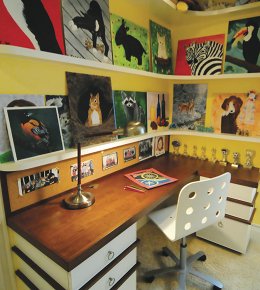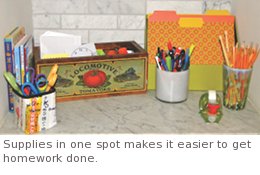 Do your kids do their homework sprawled out on the bed? Or lying on the living room floor, with cartoons on the television?
Do your kids do their homework sprawled out on the bed? Or lying on the living room floor, with cartoons on the television?
Parents, a new day has dawned! Kids are getting into good homework habits early, with spaces that showcase their interests.
Homework spaces can be carved out of any location in the home—kids’ bedrooms, a family room or a finished basement. Barbara Cashion of Evanston encourages her kids, Quinn, 10, and Claire, 8, to use the kitchen table.
“That way, I’m accessible for questions while cooking dinner,” she says. “I like the idea of all of us working in the same space.”
Cashion uses a nearby kitchen counter, originally designed as a coffee station, to house school supplies in colorful containers, such as wooden boxes from a farmer’s market.
 “A little fun never hurts,” she says. “I’m guilty as charged of buying the smelly pencils, Japanese erasers and frog tape dispensers.”
“A little fun never hurts,” she says. “I’m guilty as charged of buying the smelly pencils, Japanese erasers and frog tape dispensers.”
Architect Elissa Morgante of Wilmette designed her 12-year-old daughter’s bedroom homework space to showcase her own paintings and her favorite collections.
“We put up a horizontal rail that would accommodate a moving art show, and a shelf above houses her large stuffed animal collection,” she says.
And Annette LeCompte, interior designer with Annette LeCompte Interiors of Evanston, had custom cabinets built to keep desk clutter at bay, since her four kids use the same homework space.
“There’s a place for everything—the computer tower, the CDs, the dictionary. We even made a craft cabinet as a catch-all for modeling clay, pipe cleaners, colored paper and more,” LeCompte says.
Make your own space before school starts! Start with these 5 steps:
- Decide on the location. Either a shared family space, or the child’s own room. Make sure the space is quiet, comfortable and well lit.
- Start with a desk or table. You can add a cushion to a desk chair to make it more comfortable.
- Let your child decorate the space with artwork or posters.
- Invest in colorful school supplies. Make it fun! Stock the space with pencils, pens, erasers, paper, dictionary, index cards, glue, scissors and a calculator.
- Adjust according to what works for your kid. Happy studying!

